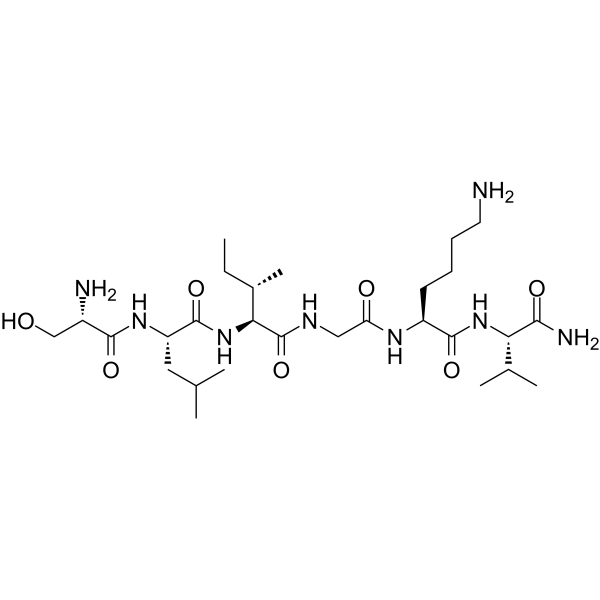| Cas No.: | 190383-13-2 |
| Chemical Name: | Protease-Activated Receptor-2, amide |
| Synonyms: | L-Valinamide,L-seryl-L-leucyl-L-isoleucylglycyl-L-lysyl-;H-Ser-Leu-Ile-Gly-Lys-Val-NH2;PAR-2 (1-6) amide (human);Ser-Leu-Ile-Gly-Lys-Val-amide;SLIGKV-NH2;(2S)-6-amino-2-[[2-[[(2S,3S)-2-[[(2S)-2-[[(2S)-2-amino-3-hydroxypropanoyl]amino]-4-methylpentanoyl]amino]-3-methylpentanoyl]amino]acetyl]amino]-N-[(2S)-1-amino-3-methyl-1-oxobutan-2-yl]hexanamide;PAR-2 (1-6) Human;PAR2 activating peptide;PAR2-AP;Par-2 Ago;SLIGKVAMIDE;PAR-2 AGONIST AMIDE;SER-LEU-ILE-GLY-LYS-VAL-NH2;PAR-2 AGONIST PEPTIDE (SLIGKV) AMIDE, HUMAN;Protease-Activated Receptor-2, amide |
| SMILES: | CC[C@@H]([C@H](NC([C@@H](NC([C@@H](N)CO)=O)CC(C)C)=O)C(NCC(N[C@H](C(N[C@H](C(N)=O)C(C)C)=O)CCCCN)=O)=O)C |
| Formula: | C28H54N8O7 |
| M.Wt: | 614.77776 |
| Sotrage: | 2 years -20°C Powder, 2 weeks4°C in DMSO,6 months-80°C in DMSO |
| Description: | Protease-Activated Receptor-2, amide (SLIGKV-NH2) is a highly potent protease-activated receptor-2 (PAR2) activating peptide. |
| In Vitro: | The PAR2-activating peptides used are: SLIGKV-OH, SLIGRL-OH, SLIGKV-NH2, SLIGRL-NH2. The synthetic agonist peptides mimicking the tethered ligand of PAR2, Ser-Leu-Ile-Gly-Lys-Val (SLIGKV-OH), Ser-Leu-Ile-Gly-Arg-Leu (SLIGRL-OH) and their amidated forms Ser-Leu-Ile-Gly-Lys-Val-amide (SLIGKV-NH2) Ser-Leu-Ile-Gly-Arg-Leu-amide (SLIGRL-NH2) have also been demonstrated being able to activate the receptor without enzymatic cleavage, therefore, have been utilised as biological tools to examine physiological functions of PAR2. Protease-Activated Receptor-2, amide is one of a four family subgroup of G-protein-coupled receptors (GPCRs), called PARs. Protease-activated receptors are distinguished from other GPCRs through their unique proteolytic mechanism of activation. For PAR2, activating proteases, such as trypsin, tryptase and coagulation factors VIIa and Xa, cleave a specific extracellular amino-terminal domain of the receptor to reveal a "tethered ligand", SLIGKV- and SLIGRL- for human and mouse/rat PAR2, respectively, which subsequently interacts with the activation domain of the receptor, initiating intracellular signaling pathways[1]. The protease-activated receptor-2 (PAR2) has been implicated in the pathogenesis of several inflammatory and autoimmune disorders, and is expressed in a wide variety of human tissues and cells. PAR2 belongs to a family of seven transmembrane domain receptor proteins that are activated by proteolysis. Enzymatic digestion exposes an N-terminus ligand sequence that binds intramolecularly to the activation site on the extracellular loop II, initiating a G-protein-mediated cell-signalling cascade and nuclear factor-kappa B (NF-κB)-regulated gene transcription[2]. |

 To enhance service speed and avoid tariff delays, we've opened a US warehouse. All US orders ship directly from our US facility.
To enhance service speed and avoid tariff delays, we've opened a US warehouse. All US orders ship directly from our US facility.




















